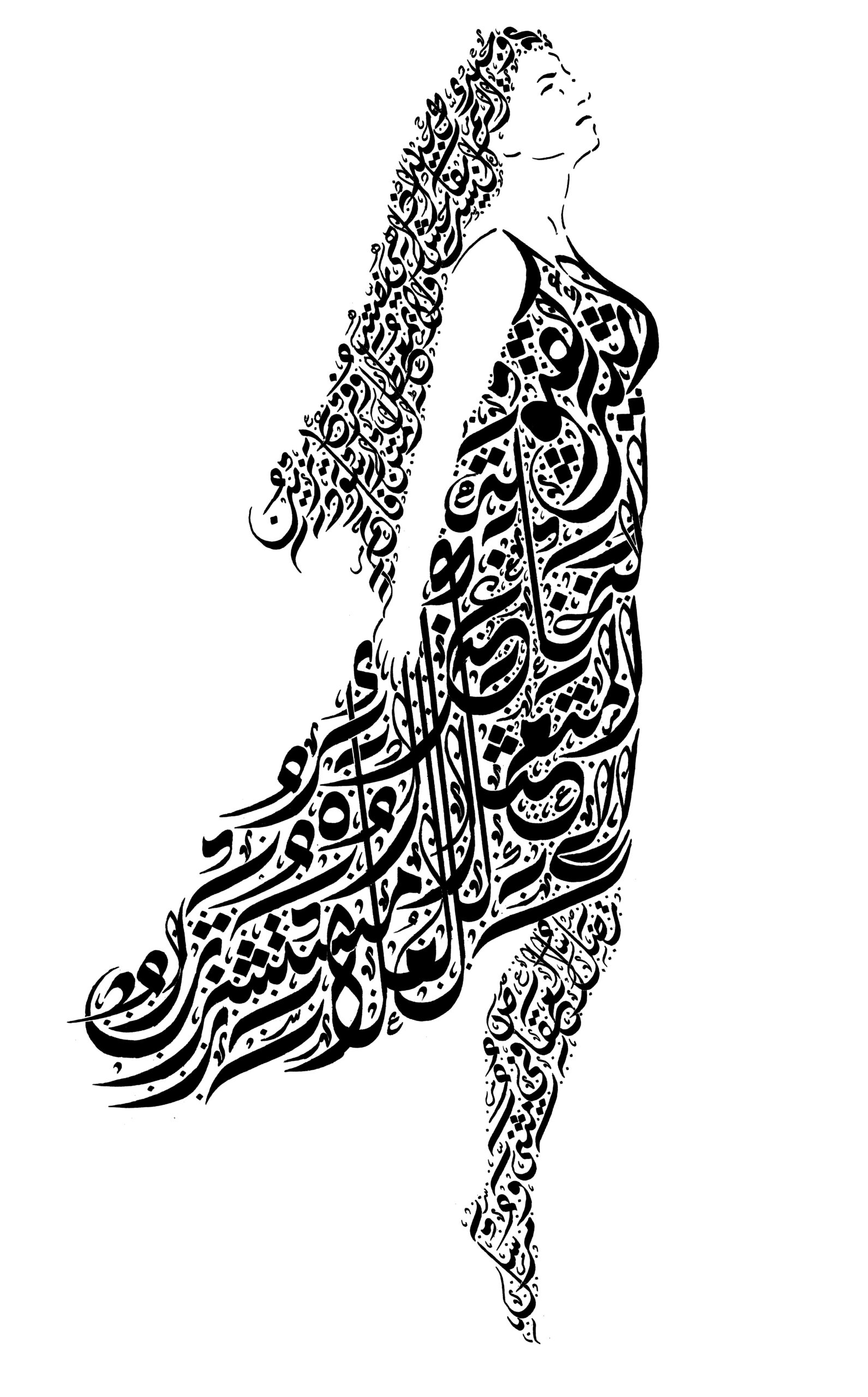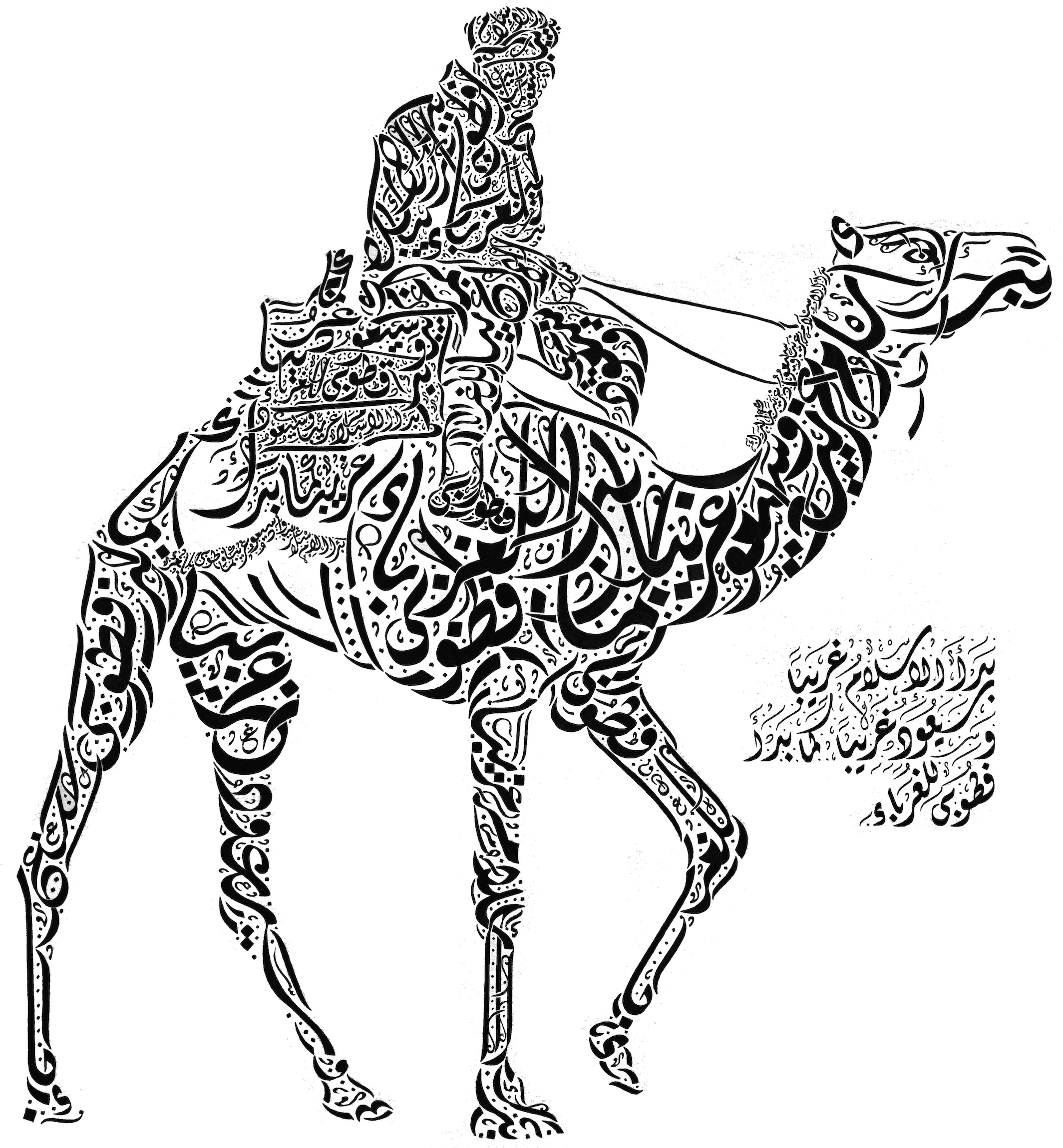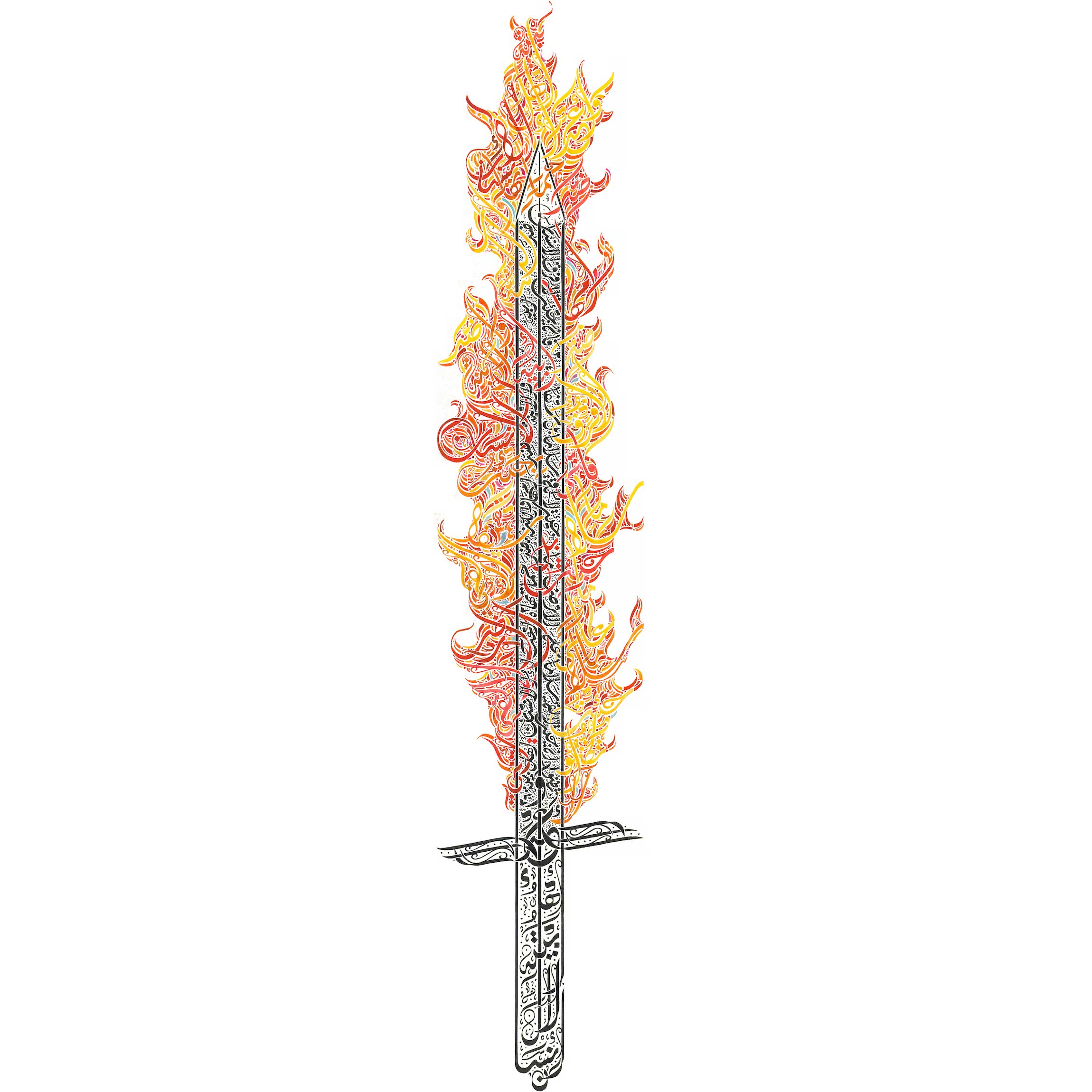
The image of a woman in a black dress is illustrated using six lines from Imru al-Qais’s 6th century classical Arabic poem “Let Us Stop and Weep” handwritten in the Jali Diwani script. “Let Us Stop and Weep” is one of the seven Mo’allaqat, a collection of Jahiliyya (Pre-Islamic) epic or long poems, all written in the 6th century, considered to be the finest examples of Pre-Islamic Arabic literature.
The Jali Diwani script was developed in 16th-century Ottoman Turkey for mostly ornamental and bureaucratic use. Its complex interweaving of letters makes it both highly ornamental and difficult to forge, hence why it was frequently used on official documents and seals. This piece is the first in a series of four, one each rendered in red, purple, blue, and green. The piece is written in several different hand-made and manufactured inks, all with light-fast pigments, written on Papier d’Elephant. The original Arabic text with 19th century English translation is as follows:
وجِـيْدٍ كَجِيْدِ الرِّئْمِ لَيْسَ بِفَاحِـشٍ
إِذَا هِـيَ نَصَّتْـهُ وَلاَ بِمُعَطَّــلِ
وفَـرْعٍ يَزِيْنُ المَتْنَ أسْوَدَ فَاحِــمٍ
أثِيْـثٍ كَقِـنْوِ النَّخْلَةِ المُتَعَثْكِــلِ
غَـدَائِرُهُ مُسْتَشْزِرَاتٌ إلَى العُــلاَ
تَضِلُّ العِقَاصُ فِي مُثَنَّى وَمُرْسَــلِ
English translation from W.A. Clauston’s “Arabic Poetry”, 1881:
Her neck was like that of a milk-white hind, but, when she raised it, exceeded not the justest symmetry; nor was the neck of my beloved so unadorned.
Her long coal-black hair decorated her back, thick and diffused, like bunches of dates clustering on the palm tree.
Her locks were elegantly turned above her head; and the riband which bound them was lost in her tresses, part braided, part disheveled.
Arabic Calligraphy – Imru al-Qais’s Lady
Dimensions: 50 x 35 cm
Year: 2014
Medium: Ink on paper. Limited Edition Giclee Print of 50 on 300gsm paper available.
Limited edition prints of 50 are available Here and can be shipped worldwide.
You can see a list of original artworks available on Saatchi
تم تصوير امرأة ترتدي ثوبًا أخضراً باستخدام ستة أبيات من القصيدة العربية الكلاسيكية لإمرؤ القيس في القرن السادس بعنوان “دعونا نتوقف ونبكي”. تم كتابتها يدويا إستخدام الخط الديواني الجلي .
إن “دعونا نتوقف ونبكي ” واحدة من سبع معلقات كتبت بالعصر الجاهلي (ما قبل الإسلام). والمعلقات هي مجموعة من القصائد الجاهلية الملحمية أو القصائد الطويلة ، وكلها كتبت في القرن السادس ، وتعتبر من أفضل الأمثلة على الأدب العربي قبل الإسلام.
تم تطوير الخط الديواني الجلي في القرن السادس عشر في الدولة العثمانية أو ما تعرف الان بتركيا و له استخدامات مختلفة منها الزينة والبيروقراطية غالباً. إن من الصعب تزوير هذه الكتابة بسبب الحروف المعقدة والمتشابكة مما يجعلها مناسبة للاستخدامات الرسمية على مستويات عالية, فاستخدمت بشكل متكرر في الوثائق والأختام الرسمية.
هذه القطعة هي الأولى من سلسلة مكونة من أربعة أجزاء و كل قطعة تقدم باللون الأحمر والأرجواني والأزرق و الأخضر.
الأبعاد: ٥٠ × ٣٥ سم
حبر على ورق ، 2014
يمكنكم النقر هنا لزيارة متجر المطبوعات المحدودة
LA DAME DE IMRU QAIS
Cliquez ici pour acheter des impressions en édition limitée
L’image d’une femme vêtue d’une robe verte est illustrée à l’aide de six vers du poème arabe classique du VIe siècle d’Imru al-Qais « Arrêtons-nous et pleurons » écrit à la main dans l’écriture Jali Diwani.
« Laissons-nous arrêter et pleurer » est l’un des sept Mo’allaqat, un recueil de poèmes épiques ou longs Jahiliyya (pré-islamiques), tous écrits au 6ème siècle, considérés comme les plus beaux exemples de la littérature arabe pré-islamique.
L’écriture Jali Diwani a été développée dans la Turquie ottomane du XVIe siècle à des fins principalement ornementales et bureaucratiques. Ses lettres complexes entrelacées le rendent à la fois très ornemental et difficile à falsifier, c’est pourquoi il était fréquemment utilisé sur les documents officiels et les sceaux. Cette pièce est la première d’une série de quatre, chacune rendue en rouge, violet, bleu et vert.
Traduction française de « Arabic Poetry », 1881 de W.A. Clauston :
Son cou était comme celui d’une biche blanc laiteux, mais, lorsqu’elle le releva, ne dépassait pas la plus juste symétrie ; le cou de ma bien-aimée n’était pas non plus si simple.
Ses longs cheveux noir charbon décoraient son dos, épais et épars, comme des bouquets de dattes agglutinés sur le palmier.
Ses mèches étaient élégamment tournées au-dessus de sa tête ; et le ruban qui les liait se perdait dans ses cheveux, en partie tressés, en partie échevelés.
Dimensions : 50x35cm
Encre sur papier, 2014








